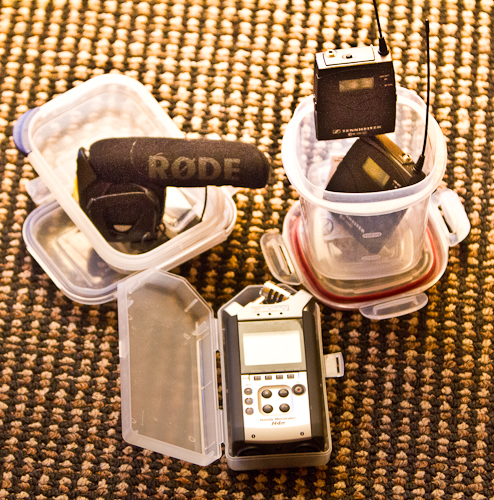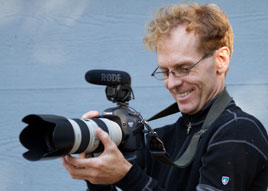After testing and configuring a number of recording devices and mics we have settled on the following set-up. The upcoming Borneo/Sumatra trip will be the first full field test so we’ll post more from the field and when we are back in March. Until then, here are our initial challenges to address:
- Portability/Low battery drain
- Universal recording medium (cards)
- Size – Ability to attach to our cameras in a compact manner
- Field dependability
That sounds like a pretty simple request. It is if you are recording in downtown Portland or anywhere you can bolt off and get replacement parts and batteries should any element of the system falter; Not so convenient in the remote rainforests of Borneo and Sumatra.

Our GAD field recording system - clockwise from center bottom - Zoom H4n recorder, RØDE VideoMic Pro, and Sennheiser ew 112-p G3 wireless mic/receiver - all have small sealable plastic containers and silica jell (only the Zoom comes shipped with a container.)
Recorder
This was perhaps the biggest no-brainer. The Zoom H4n recorder is considered state-of -the-art for portable recording. It’s been called the Swiss-Army knife of handheld digital recorders. The H4n uses compact SD or high-capacity SDHC memory cards of up to 32GB. Unlike other media such as tape or discs, SD cards produce no mechanical noise, are not disturbed by vibrations and the cards are available globally.
The Pros: Intuitive and easy to use. Really convenient to play back the previous recording with the press of a button to make sure you got everything – that ease is critical security when we simply can’t re-record one-off field opportunities. Back-lit LCD screen is invaluable in the tropics. Battery – power save mode (sacrificing a few features) otherwise average (about 4-5 hours?) on 4-AAs. Getting XLR inputs and phantom power – great.
Cons: No belt clip – kinda an “oh duh.” (Perhaps more here after this first rugged extended field test – I will link here to an update at that point.)
Microphones
Mics were a bit more problematic. We needed two solutions – one for interviews, a wireless mic, and one for general and ambient sound.
For the interviews we will be starting with the Sennheiser ew 112-p G3. The small wireless unit is pretty much the industry standard – small, portable, wonderfully accurate and “full”-sounding. Belt clips are super secure and allow attaching the transmitter to folks like trackers and anti-poacher who often run through the forest and stress the unit. Threaded mounts for all the cables are great – we only wish all our other mounts were so securely designed.
The most challenging element was a small shotgun with full-sound and of quality we could rely, we chose the RØDE VideoMic Pro. The mic is designed as a true DSLR and camcorder mic. A super-cardioid polar pattern ensures that surrounding audio is minimised, and your recording is focused on the subject directly in-front of the camera. Audio is both measurable and subjective – and we found the RØDE gave a “fullness” we weren’t hearing in the sound reproduced by other brands. Size on the RØDE VideoMic Pro was critical as many mics we tested projected too far forward intruding into the field-of-view on our super wide lenses (Canon 8-15mm and Tokina 11-16mm.)
******
A special thanks to Brenda @Pro Photo Supply for all her help on audio gear.
As mentioned previously – Skye and I will post all our audio thoughts here and links to this posting when we return in mid-March from this initial field work.

